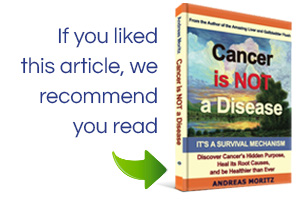By: Dr. Mercola
Source: Mercola.com
In 2011, it was estimated that nearly 1.6 million people would be diagnosed with cancer, and more than 570,000 would die of the disease.
With an epidemic such as this, virtually every safe preventive strategy available deserves attention.
But when a simple, and virtually free, strategy emerges that shows promise in reducing rates of not one, not two, but potentially dozens of different types of cancer, it needs to be shouted from the rooftops.
So open your ears — such a strategy does exist: Sun Exposure and Vitamin D!
Sunlight Protects Against Cancer by Stimulating the Production of Vitamin D
New research just in confirms that if you want to slash your risk of cancer, it’s essential that you spend adequate time in the sun or a safe tanning bed, or at the very least supplement with proper amounts of vitamin D3.
Specifically, researchers found that, consistently, the higher the solar UVB, the lower the incidence of 15 different types of cancer, including:
The review, based largely on three studies from the United States, one each from Australia, China, France, Japan, and Spain, and eight multi-country studies of cancer incidence rates that collectively examined more than 100 countries, concluded:
“The evidence for the UVB-vitamin D-cancer hypothesis is very strong in general and for many types of cancer in particular.”
Further, they noted that weaker evidence exists that solar UVB also leads to lower rates of cancer of the following types:
More Than 200 Studies Show Vitamin D Plays a Role in Cancer
Theories linking vitamin D to certain cancers have been tested and confirmed in more than 200 epidemiological studies, and understanding of its physiological basis stems from more than 2,500 laboratory studies, according to epidemiologist Cedric Garland, DrPH, professor of family and preventive medicine at the UC San Diego School of Medicine. Here are just a few highlights into some of the most noteworthy findings:
- Some 600,000 cases of breast and colorectal cancers could be prevented each year if vitamin D levels among populations worldwide were increased, according to previous research by Dr. Garland and colleagues. And that’s just counting the death toll for two types of cancer.
- Optimizing your vitamin D levels could help you to prevent at least 16 different types of cancer including pancreatic, lung, ovarian, prostate, and skin cancers.
- A large-scale, randomized, placebo-controlled study on vitamin D and cancer showed that vitamin D can cut overall cancer risk by as much as 60 percent. This was such groundbreaking news that the Canadian Cancer Society has actually begun endorsing the vitamin as a cancer-prevention therapy.
- Light-skinned women who had high amounts of long-term sun exposure had half the risk of developing advanced breast cancer (cancer that spreads beyond your breast) as women with lower amounts of regular sun exposure, according to a study in the American Journal of Epidemiology.
- A study by Dr. William Grant, Ph.D., internationally recognized research scientist and vitamin D expert, found that about 30 percent of cancer deaths — which amounts to 2 million worldwide and 200,000 in the United States — could be prevented each year with higher levels of vitamin D.
On a personal level, you can decrease your risk of cancer by MORE THAN HALF simply by optimizing your vitamin D levels with sun exposure. And if you are being treated for cancer it is likely that higher blood levels—probably around 70-100 ng/ml—would be beneficial. Vitamin D’s protective effect against cancer appears to work in multiple ways, including:
- Increasing the self-destruction of mutated cells (which, if allowed to replicate, could lead to cancer)
- Reducing the spread and reproduction of cancer cells
- Causing cells to become differentiated (cancer cells often lack differentiation)
- Reducing the growth of new blood vessels from pre-existing ones, which is a step in the transition of dormant tumors turning cancerous
What are You Waiting For? Why Not Start Optimizing Your Levels Now?
Many Americans simply are not getting enough vitamin D to even maintain healthy bones, much less getting enough to fight off diseases like cancer. There are two primary reasons for this, one being that many people are still worried that going out in the sun will lead to skin cancer. It’s important to understand, however, that the risk of skin cancer from the sun comes only from excessive exposure.
When used properly, sunlight exposure will help you prevent cancer.
To optimize your levels, you need to expose large portions of your skin to the appropriate amounts of sunlight. And, contrary to popular belief, the best time to be in the sun for vitamin D production is actually as near to solar noon as possible. During this time you need the shortest exposure time to produce vitamin D because UVB rays are most intense at this time. Plus, when the sun goes down toward the horizon, the UVB is filtered out much more than the dangerous UVA.
Just be cautious about the length of your exposure. You only need enough exposure to have your skin turn the lightest shade of pink. Once you reach this point your body will not make any additional vitamin D due to its self-regulating mechanism. Any additional exposure will only cause harm and damage to your skin.
Vitamin D from sun exposure or a safe tanning bed is the BEST way to optimize your vitamin D levels. Safe tanning beds have electronic ballasts rather than magnetic ballasts, which helps you avoid unnecessary exposure to health-harming EMF fields. They also have less of the dangerous UVA than sunlight, while unsafe ones have more UVA than sunlight. The second primary reason so many are vitamin-D-deficient, aside from lack of sun exposure, has to do with misinformation about supplementation.
If You Use a Vitamin D Supplement, You Need to Know This …
First, let me repeat that sun exposure or the use of a safe tanning bed are the best options to optimize your vitamin D levels. You cannot overdose when getting your vitamin D from sun exposure, as your body has the ability to self-regulate and only make what it needs. If these options are not available, a supplement can be used, but keep the following in mind:
- According to the most recent findings by Carole Baggerly, founder of GrassrootsHealth, her research of nearly 10,000 people shows the ideal adult dose appears to be 8,000 IU’s a day to get most into the healthy range.
- When you do supplement with vitamin D, you’ll only want to supplement with natural vitamin D3 (cholecalciferol). Do NOT use the synthetic and highly inferior vitamin D2, which is the one most doctors will give you in a prescription most of the time unless you ask specifically for D3.
- Get your vitamin D blood levels checked! The only way to determine the correct dose is to get your blood tested since there are so many variables that influence your vitamin D status. I recommend using Lab Corp in the U.S.
- The correct test your doctor needs to order is 25(OH)D, also called 25-hydroxyvitamin D, which is the better marker of overall D status. This is the marker that is most strongly associated with overall health.
- As an aside, there is evidence that the safety of vitamin D is dependent on vitamin K, and that vitamin D toxicity (although very rare with the D3 form) is actually aggravated by vitamin K2 deficiency. So if you take oral vitamin D, ideally you should take vitamin K2 as well or use organic fermented foods that are high in vitamin K2, as you need about 150 mcg per day.
- The “normal” 25-hydroxyvitamin D lab range is between 20-56 ng/ml. But, this conventional range is really a sign of deficiency, and is too broad to be ideal. In fact, your vitamin D level should not be below 32 ng/ml, and any levels below 20 ng/ml are considered serious deficiency states, increasing your risk of cancer and autoimmune diseases like multiple sclerosis and rheumatoid arthritis, just to name a few.The OPTIMAL value that you’re looking for is explained in the chart below. Remember that if you were in the sun nearly every day with large amounts of your skin exposed and not taking any oral vitamin D, your level would be around 100 ng/ml.
This range applies for everyone: children, adolescents, adults and seniors. Remember, unless you get a deep dark tan, which is a pretty good gauge that your vitamin D levels are where they need to be, it is wise to get your blood levels checked; that is the only way to know for certain you have reached therapeutic levels.
Given that optimizing your vitamin D levels is one of the simplest and most profound steps you can take to improve and maintain your health, including helping you to prevent cancer, this is information that could, quite literally, save your life.
To view the original article click here.
To reprint this article, visit the source website for reprinting guidelines










